Vietnamese cuisine is a vibrant tapestry of flavors, textures, and aromas that extends far beyond the internationally acclaimed phở and bánh mì. It is a reflection of the country’s diverse geography, rich history, and deep-seated cultural values. Each region boasts its own culinary identity, shaped by local ingredients and traditions, offering a delightful exploration for any food enthusiast.
Across Vietnam, cooks meticulously transform the abundance of fresh produce, fragrant herbs, and quality proteins into unforgettable meals. Northern cuisine is often praised for its subtle balance and simplicity, while central Vietnam delights with bold spices and intricate presentations, a nod to its imperial past. Southern dishes frequently incorporate a touch of sweetness, reflecting the region’s fertile lands and waterways. Wherever your travels take you in this fascinating country, savoring the local Vietnam specialties is an essential part of the experience.
Iconic Vietnam Specialties You Must Try
Prepare your taste buds for an adventure as we delve into some of the most celebrated Vietnam specialties. These dishes not only offer incredible flavors but also tell stories of tradition, adaptation, and regional pride. From steaming bowls of noodle soup to crispy savory pancakes, the variety is astounding.
Each dish represents a piece of Vietnam’s soul, from humble street food origins to elaborate ceremonial preparations. Understanding the ingredients, the preparation, and the context behind these culinary creations enhances the enjoyment and provides deeper insight into the culture. Let’s explore some of the most beloved Vietnam specialties.
1. Phở
Phở is arguably the most recognizable of all Vietnam specialties. The name refers specifically to the wide, flat rice noodles central to the dish. This comforting soup typically features tender slices of medium-rare beef or succulent boiled chicken swimming in a rich, aromatic beef broth.
The two main varieties, phở Hanoi from the north and phở Nam from the south, offer distinct experiences. Hanoi’s version is known for its clear broth and simple garnishes like lemon and chili, while phở Nam boasts a murkier broth and a generous bouquet of fresh herbs, including bean sprouts, basil, and mint. The magic often lies in the broth, infused with warming spices like star anise, clove, and cinnamon for a natural sweetness. Often consumed for breakfast in Vietnam, phở is a beloved staple found on nearly every street corner.
Fun Things to Do in Kissimmee Florida
Where To Go In Waikiki – Your Ultimate Guide to Hawaii’s Iconic Beachfront
The Best Things to Do in Naples – Your Ultimate Italian Experience
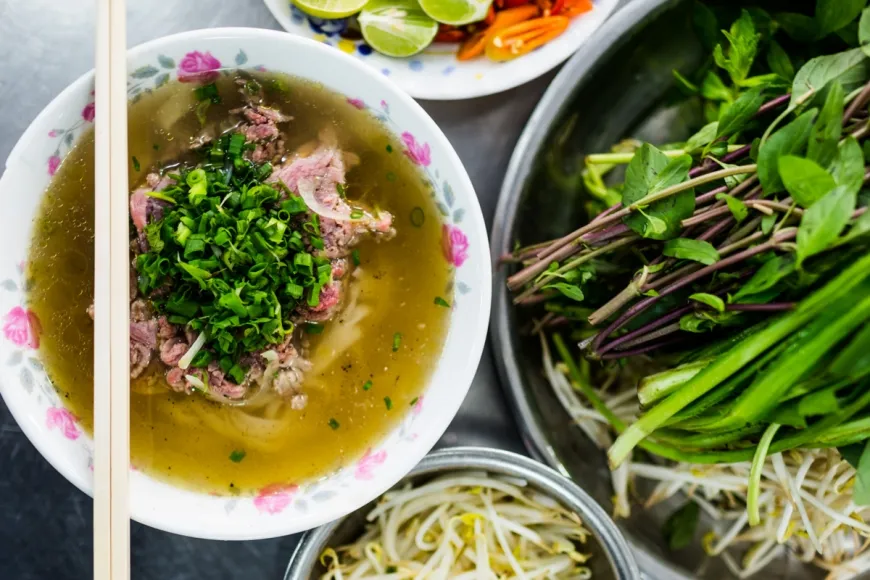 Authentic bowl of Pho, a classic Vietnamese specialty soup with noodles and meat
Authentic bowl of Pho, a classic Vietnamese specialty soup with noodles and meat
Try it: Pho Thin, 13 Lo Duc, Hai Ba Trung District in Hanoi or Pho Hoa, 260C Pasteur Street, District 3 in Ho Chi Minh City
2. Bánh Mì
While baguettes are a French colonial legacy, bánh mì has been transformed into a uniquely Vietnamese specialty. The soft, airy interior of the baguette is typically spread with pâté and margarine, then generously filled with a vibrant combination of pickled vegetables, fresh cilantro, savory pork belly, pork floss, and cool cucumber slices.
Taking a bite into the crusty exterior gives way to a medley of textures and flavors packed inside the warm roll. It’s a perfect example of how Vietnamese cuisine creatively adapted foreign influences to create something entirely new and delicious. Bánh mì is a popular on-the-go meal, representing the dynamic street food culture of Vietnam.
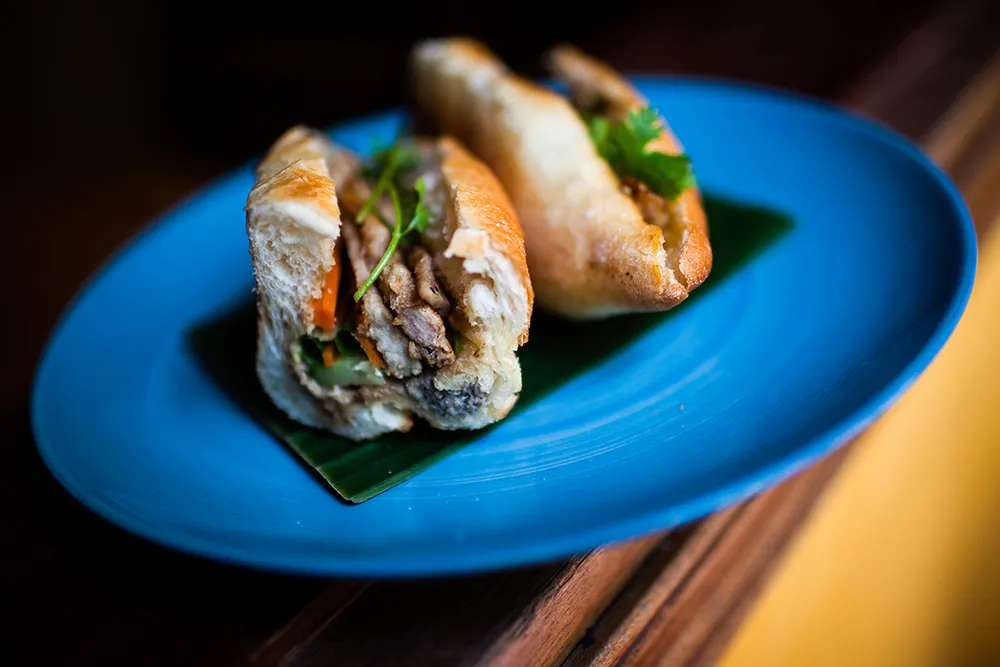 Crispy Vietnamese Banh Mi sandwich filled with pork, herbs, and pickled vegetables
Crispy Vietnamese Banh Mi sandwich filled with pork, herbs, and pickled vegetables
Try it: Banh My Phuong, 2B Phan Chau Trinh, Hoi An
3. Cơm Tấm
Originating from the necessity of utilizing broken rice grains, cơm tấm has evolved from a humble farmer’s meal into a cherished working-class staple and one of the hearty Vietnam specialties. Despite its simple beginnings, a plate of cơm tấm can be surprisingly elaborate and decadent.
The most popular preparation is cơm tấm sườn nướng ốp la, featuring a perfectly fried egg atop a generous mound of broken rice, accompanied by a caramelized grilled pork chop. The dish is finished with a drizzle of nước chấm (a sweet and savory fish sauce mixture with chili and sugar) and aromatic green onion oil. Sides of pickled shredded carrots and daikon, cucumber and tomato slices, and crunchy fried pork rinds and shallots complete this satisfying meal.
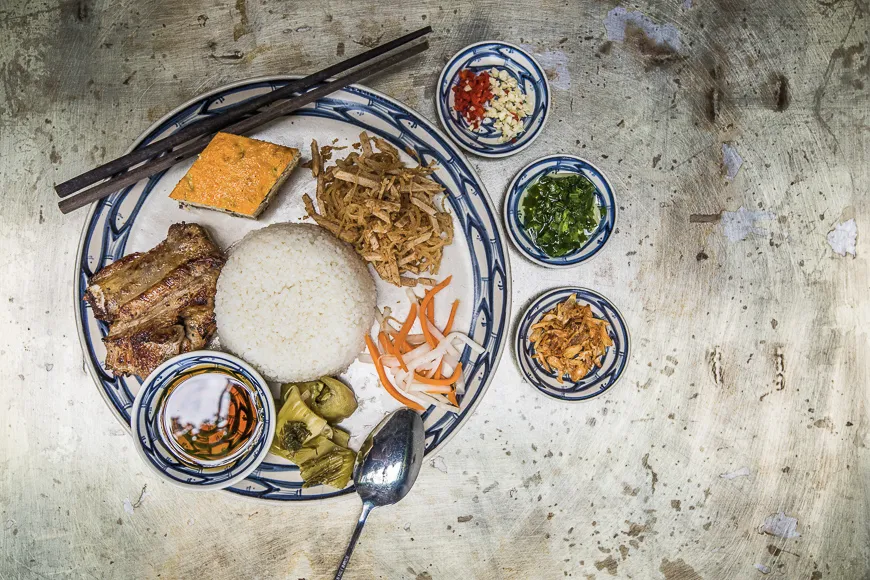 Com Tam, Vietnamese broken rice dish with grilled pork chop and fried egg
Com Tam, Vietnamese broken rice dish with grilled pork chop and fried egg
Try it: A family-operated stall on 260 Vo Van Tan, District 3, Ho Chi Minh City
4. Bún Bò Huế
Representing the imperial city of Hue’s legendary cuisine, bún bò huế is a powerful and visually striking soup, cementing its place among must-try Vietnam specialties. The characteristic vibrant red broth signals its intense flavor profile, achieved by hours of simmering beef bones with generous amounts of lemongrass, creating a citrusy and slightly spicy base.
Tender beef shanks and flash-boiled vegetables add depth and texture. The name bún bò means beef noodles, but the soup often includes chả lụa, a smooth sausage made from ham paste with a texture akin to firm tofu. This complex and aromatic soup showcases the bold flavors typical of Central Vietnamese cooking.
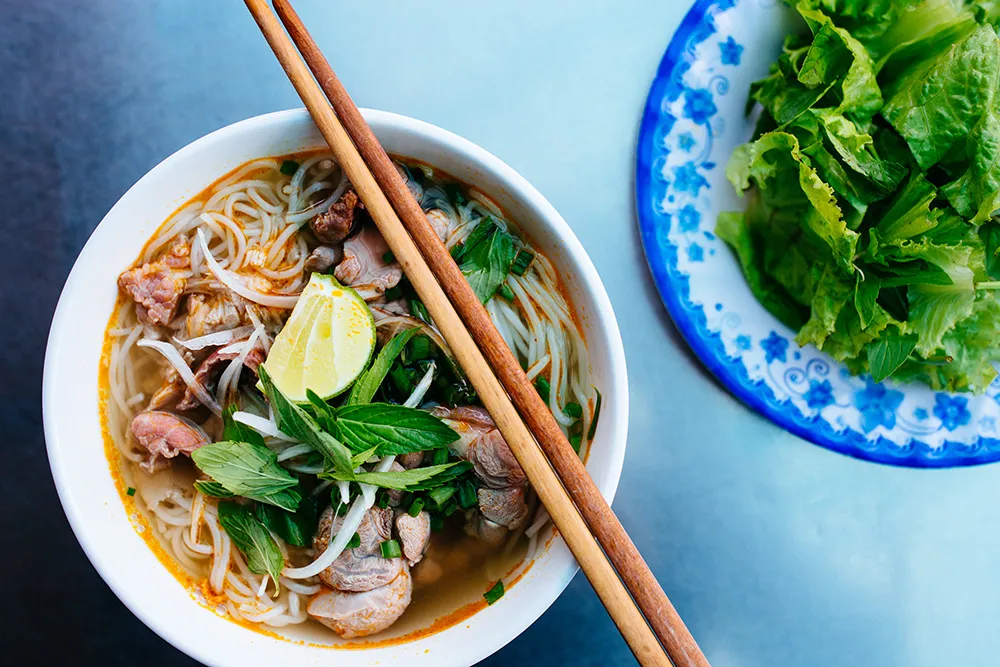 Bun Bo Hue soup with noodles, beef, and sausage in a rich red broth
Bun Bo Hue soup with noodles, beef, and sausage in a rich red broth
Try it: Quan Bun Bo Hue, 19 Ly Thuong Kiet Street, Hue
5. Cao Lầu
Unique to the ancient trading port of Hoi An, cao lầu is unlike any other noodle dish and a true Hoi An specialty. This dish reflects Hoi An’s historical position as a melting pot, blending Japanese, Chinese, and Vietnamese influences. Thick, substantial noodles reminiscent of Japanese udon are the base.
Slices of Chinese-style barbecued pork are fanned over the noodles, which are then dressed with a spice-laden broth. Fresh herbs and crunchy pork cracklings provide contrasting textures and aromas. Legend has it that authentic cao lầu must be made using water from the thousand-year-old Ba Le well in Hoi An, believed to have special properties that contribute to the noodles’ unique texture.
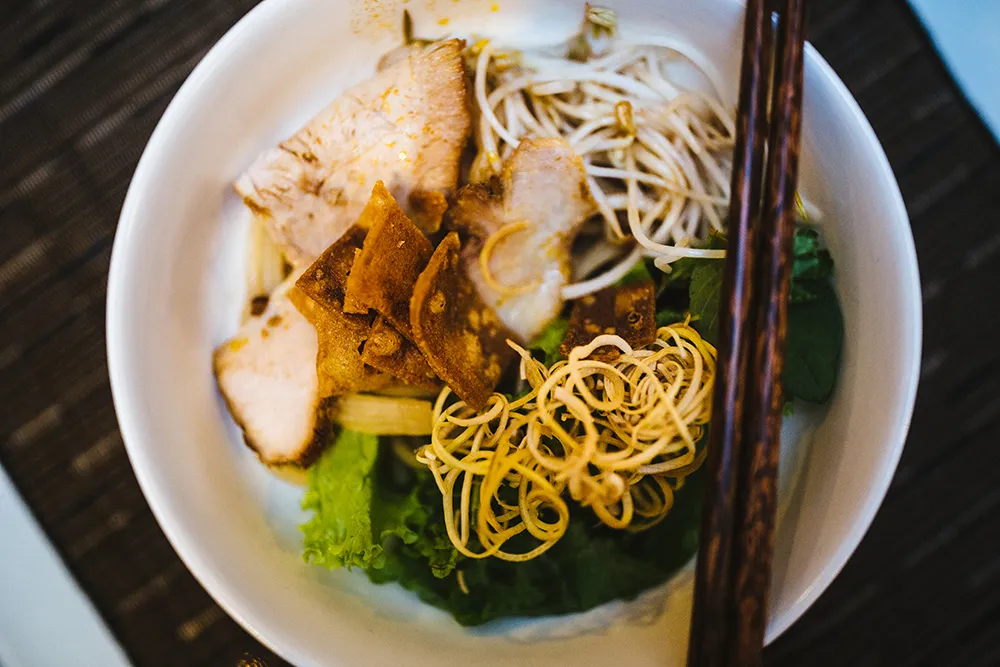 Cao Lau noodles with barbecued pork, herbs, and croutons in Hoi An, Vietnam
Cao Lau noodles with barbecued pork, herbs, and croutons in Hoi An, Vietnam
Try it: Thanh Cao Lau, 24 Thai Phien St, Hoi An
6. Cơm Gà
Chicken and rice is a universally loved combination, but in Hội An, it becomes a refined Vietnam specialty known as cơm gà. This dish elevates the simple pairing using fresh ingredients sourced from the countryside. Tender chicken strips are shredded and mixed with flavored fish sauce and onions, served alongside a bowl of aromatic turmeric rice.
Pickled shallots, radish, and fresh herbs are served on the side to add brightness and acidity. Hội An cooks often have secret touches to make their turmeric rice stand out. Classic Hội An chicken rice is typically garnished with Vietnamese coriander and hot mint, balancing the zesty chicken marinade and adding freshness. After exploring the historic Ancient Town, a plate of golden cơm gà is the perfect treat.
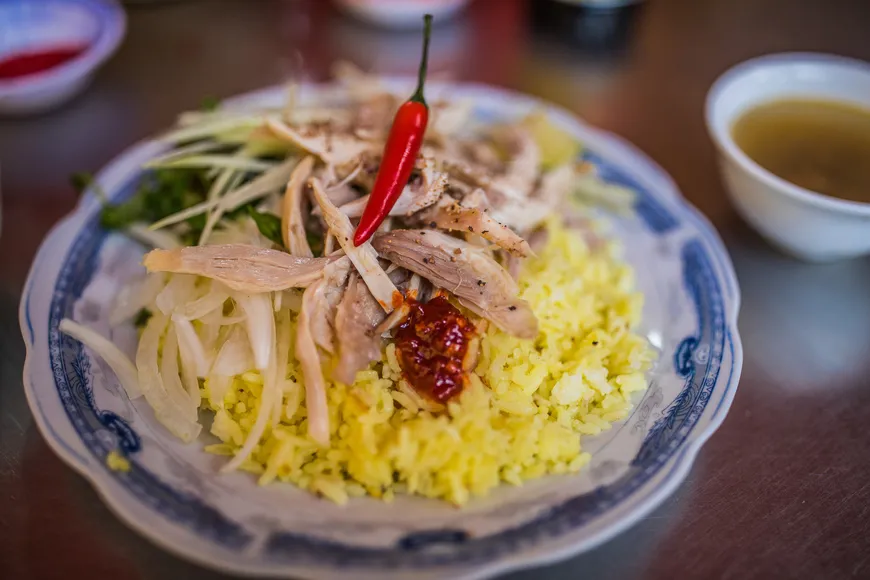 Vietnamese Com Ga, chicken rice with herbs and pickled vegetables
Vietnamese Com Ga, chicken rice with herbs and pickled vegetables
Try it: Com Ga Hien, 539 Hai Ba Trung St, Hoi An
7. Mì Quảng
Often described as part soup, part salad, mì quảng is a graceful noodle dish from the Quang Nam province in Central Vietnam, showcasing its versatility among Vietnam specialties. Despite its elegant presentation, mì quảng is firmly rooted in street food culture. Its distinctively yellow noodles get their vibrant color from turmeric, which also infuses the rich, peanut oil-enhanced broth.
Only a small amount of broth is used, making it less of a soup and more of a sauced noodle dish. Toppings vary widely and can include shrimp, chicken, pork belly, or even snakehead fish. Mì quảng is traditionally enjoyed with sliced banana flowers, Vietnamese coriander, basil, and bánh tráng me, crispy toasted sesame rice crackers, adding crunch and fresh aromatics.
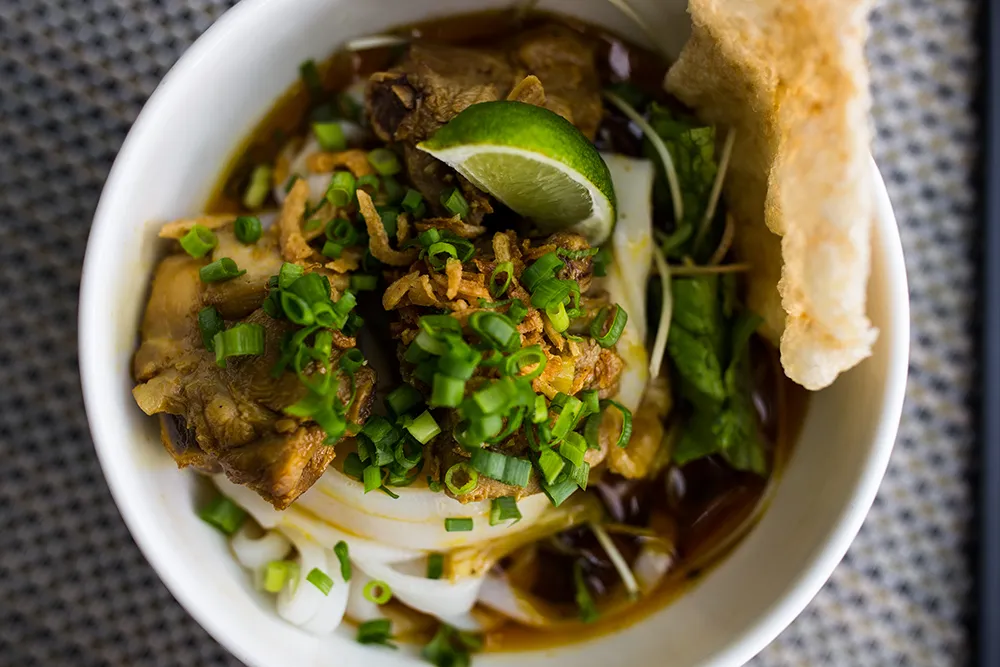 Bowl of Mì Quảng noodles with toppings and herbs, a specialty of Central Vietnam
Bowl of Mì Quảng noodles with toppings and herbs, a specialty of Central Vietnam
Try it: Quan Mi Quang Ba Mua, 95 Nguyen Tri Phuong, Chinh Gian, Thanh Khe, Da Nang
8. Bánh Xèo
A creation from the Mekong Delta region, bánh xèo is a popular savory crepe enjoyed across southern and central Vietnam. Watching bánh xèo being made is a captivating experience; the batter sizzles loudly when it hits the hot pan (hence the name xèo, meaning sizzling).
The edges curl and turn golden as the skilled cook swirls the pan to spread the rice flour and coconut milk batter thinly. Turmeric gives the crepe its characteristic yellowish hue. This crispy pancake, sometimes compared to a French crepe, is filled with ingredients like boiled pork slices, minced pork, bean sprouts, and shrimp, then folded in half. A good bánh xèo should be crispy, not soggy, and is best eaten fresh off the skillet.
 Crispy Vietnamese Banh Xeo pancake filled with shrimp and vegetables
Crispy Vietnamese Banh Xeo pancake filled with shrimp and vegetables
Try it: Banh Xeo 46A, 46A D Dinh Cong Trang, District 3, Ho Chi Minh City
9. Bún Chả
catapulted to international fame after a high-profile dinner, bún chả has long been a beloved Vietnam specialty in Hanoi’s Old Quarter. Around lunchtime, the irresistible aroma of pork grilling over hot charcoal fills the air, drawing hungry locals to street-side stalls.
This classic northern dish features cold bún (rice vermicelli), seasoned grilled pork belly slices, and succulent minced pork patties swimming in a warm, fish sauce-based broth. A generous mound of fresh herbs and salad greens is served alongside. The traditional way to enjoy bún chả is to dip small bundles of vermicelli into the broth with the pork and alternate bites with the fresh greens, creating a harmonious mix of flavors and textures.
 Bun Cha, grilled pork patties and sliced pork belly served with vermicelli noodles and dipping broth
Bun Cha, grilled pork patties and sliced pork belly served with vermicelli noodles and dipping broth
Try it: Bun Cha Huong Lien (also known as Bun Cha Obama), 24 Le Van Huu, Phan Dinh Ho, Hai Ba Trung, Hanoi
10. Xôi
Xôi, or Vietnamese sticky rice, offers a unique take on a staple found across the region. This dense, glutinous rice dish is served in both savory (xôi mặn) and sweet (xôi ngọt) variations. Xôi mặn, a popular and inexpensive breakfast fix, is often topped with ingredients like dried shrimp, pork floss, and fried shallots.
For those with a sweet tooth, there are over 20 types of xôi ngọt. A visually stunning option is xôi ngũ sắc, the five-colored sticky rice. This vibrant dish features swirls of purple, green, red, yellow, and white sticky rice, colored naturally with plant extracts, offering a feast for both the eyes and the palate.
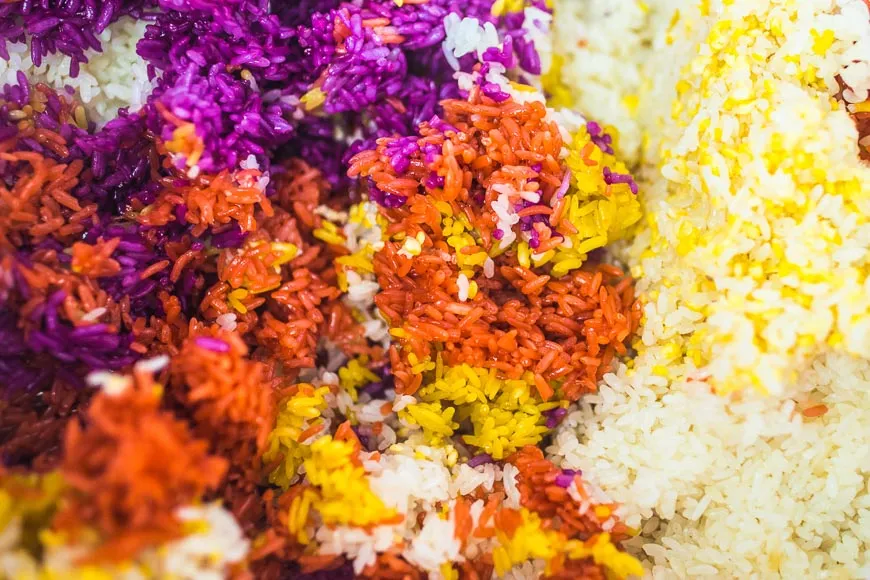 Five-colored sticky rice, Xoi ngu sac, a vibrant Vietnamese specialty
Five-colored sticky rice, Xoi ngu sac, a vibrant Vietnamese specialty
Try it: Xoi Yen, 35B Nguyen Huu Huan, Ly Thai To, Hoan Kiem, Hanoi
11. Bánh Bèo
More of an appetizer or snack, bánh bèo are delicate steamed rice cakes from Hue, Central Vietnam, akin to Vietnamese tapas. These bite-sized Vietnam specialties are served in small dishes, each holding a thin, chewy disk.
Each cake is typically topped with a spoonful of creamy mung bean paste and toasted shrimp flakes. They are then garnished with either crunchy croutons or the more indulgent tép mỡ, crispy fried pork fat. A well-made bánh bèo should have a slight dimple in the center from steaming. They are traditionally enjoyed with a side of nước chấm.
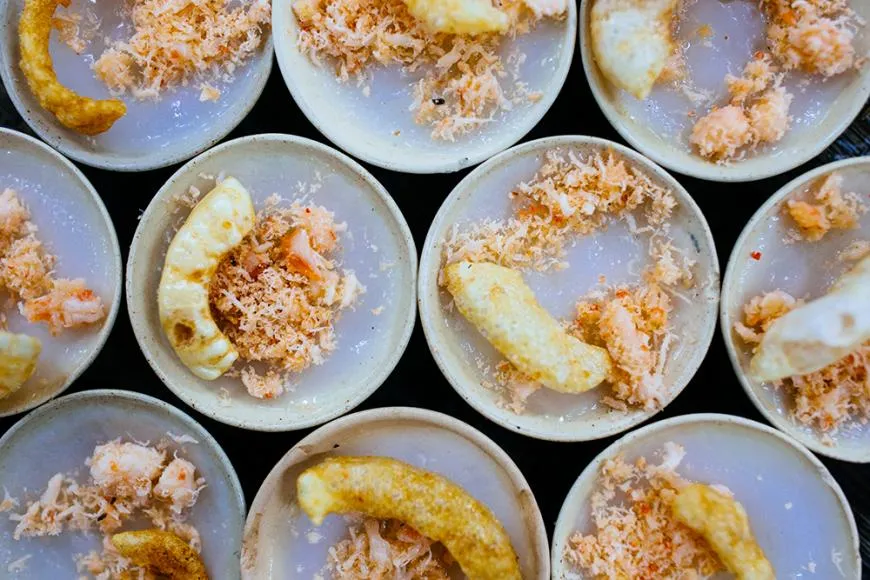 Small steamed rice cakes topped with shrimp and pork cracklings, Banh Beo from Hue
Small steamed rice cakes topped with shrimp and pork cracklings, Banh Beo from Hue
Try it: Quan Hanh, 11 Pho Duc Chinh (South Bank), Hue
12. Bún Riêu
The harmonious combination of crab and tomato makes bún riêu a truly distinctive Vietnam specialty. This hearty soup is known for its acidity and rich flavor. The core components include slippery bún noodles, fresh crab meat, soft tofu blocks, and stewed tomatoes, creating a vibrant, flavorful broth.
Preparing an authentic bowl of bún riêu is a labor-intensive process. After separating the crab meat, the shells are often pounded and strained to form the flavorful base of the broth. Floating in the soup are soft clusters of minced crab combined with ground pork and egg, offering melt-in-your-mouth goodness. This soup is a testament to the creativity and effort often put into Vietnamese home cooking and street food.
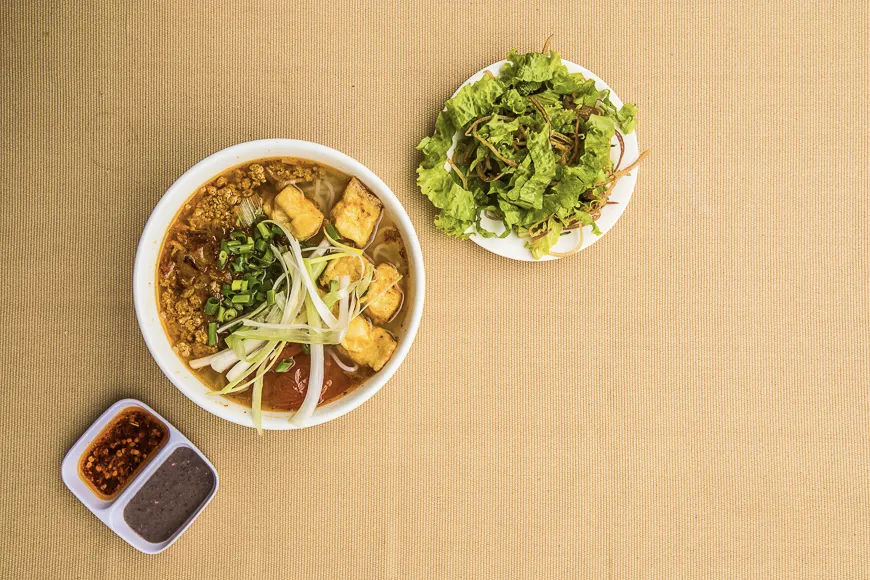 Bowl of Bun Rieu soup with vermicelli noodles, crab meat, and tomatoes
Bowl of Bun Rieu soup with vermicelli noodles, crab meat, and tomatoes
Try it: Bún Riêu Cua Thanh Hồng, 42 Hòa Mã, Ngô Thì Nhậm, Hai Bà Trưng, Hanoi
13. Gỏi Cuốn
Known internationally as fresh spring rolls or summer rolls, gỏi cuốn are a refreshing and healthy Vietnam specialty packed with fresh ingredients. The semi-transparent wrapper is made from softened rice paper sheets. Inside, you’ll find a colorful array of leafy greens, mint, coriander, a protein (often pork tenderloin and shelled shrimp), and a stalk of garlic chive peeking out.
These tightly wrapped rolls are served at room temperature and are meant for dipping. Common dipping sauces include a nutty hoisin peanut sauce or the classic sweet and savory nước chấm. Gỏi cuốn offers a burst of fresh flavors and textures, making them a popular appetizer or light meal choice.
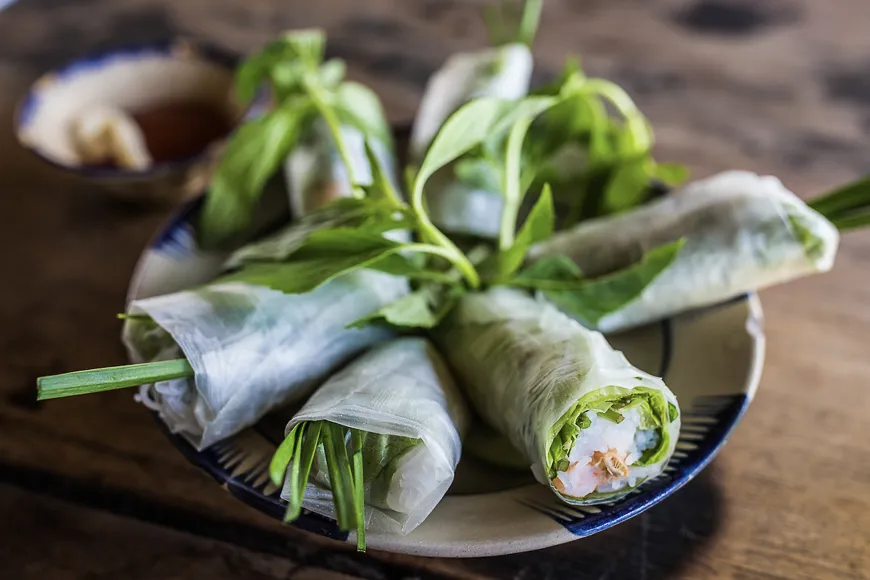 Fresh Vietnamese spring rolls, Goi Cuon, filled with shrimp, pork, herbs, and vermicelli
Fresh Vietnamese spring rolls, Goi Cuon, filled with shrimp, pork, herbs, and vermicelli
Try it: Quan An Ngon, 18 Phan Boi Chau, Hoan Kiem, Hanoi
14. Bánh Căn
Bánh căn are delightful bite-sized savory pancakes particularly popular in south-central Vietnam. Cooked over an open flame in a special earthenware grill, they are made from a batter of rice flour, a cracked quail egg, and green onions. Each mini pancake offers a satisfying texture and flavor.
Traditionally served plain, modern variations of bánh căn are often topped with shrimp or pork. They are typically dipped into a bowl of light broth garnished with green onions and sometimes small meatballs, adding another layer of flavor and moisture to the crispy cakes. These small, flavorful bites are perfect for snacking.
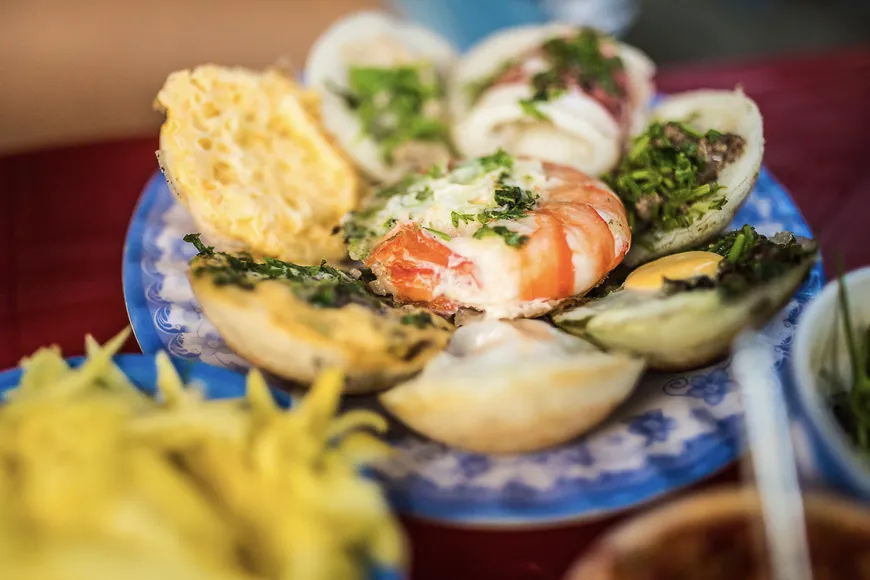 Bite-sized Banh Can savory pancakes with toppings cooked in earthenware molds
Bite-sized Banh Can savory pancakes with toppings cooked in earthenware molds
Try it: Phan Rang, 106 Trương Định, Phường 9, Quận 3, Ho Chi Minh City
15. Hủ Tiếu Nam Vang
Hủ tiếu is a ubiquitous street food item in southern Vietnam, representing the Vietnamese adaptation of regional noodle soups like Cambodia’s kuy teav and Thailand’s guay tiew. It typically features chewy noodles served in a clear broth made from pork bones. The dish can be ordered “wet” (nước) with the broth or “dry” (khô) with sauce, and the broth served on the side.
The definitive version is Hủ Tiếu Nam Vang. This recipe often includes pork on the bone, boiled liver slices, a quail egg, and shrimp. For the adventurous, chunks of congealed pork blood sometimes make an appearance. The peppery broth, often sweetened with rock sugar, is garnished with chopped green onions, offering a comforting and complex flavor profile that makes it a sought-after Vietnam specialty in the south.
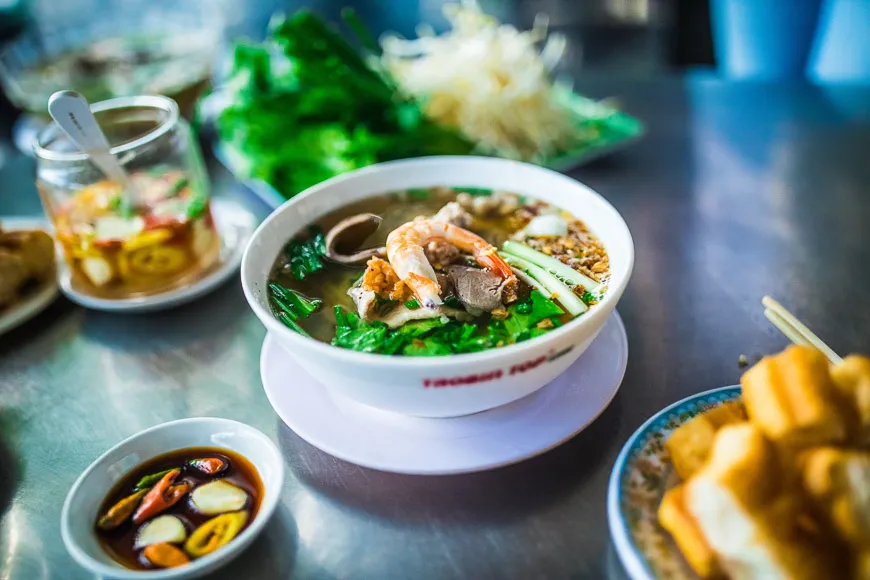 Bowl of Hu Tieu Nam Vang noodles with pork, shrimp, and egg in broth
Bowl of Hu Tieu Nam Vang noodles with pork, shrimp, and egg in broth
Try it: Hu Tieu Co Huong, 152/7/2 Ly Chinh Thang, Ward 7, District 3, Ho Chi Minh City
16. Chả Cá
Chả cá is a unique and highly-praised Vietnam specialty originating from Hanoi, the capital. It stands out for its vibrant combination of flavors, textures, and colors. Flaky white fish chunks, marinated in turmeric for a beautiful yellow hue, are sautéed in butter on a hot skillet right at your table.
Generous amounts of fresh dill and green onion are then added to the skillet, wilting slightly as they cook and infuse the fish with their aromatic scent. It’s a visually appealing dish, perfect for a photo before the herbs fully wilt. Served with rice vermicelli, roasted peanuts, and shrimp paste, chả cá offers a delightful sensory experience and a taste of northern Vietnamese culinary tradition.
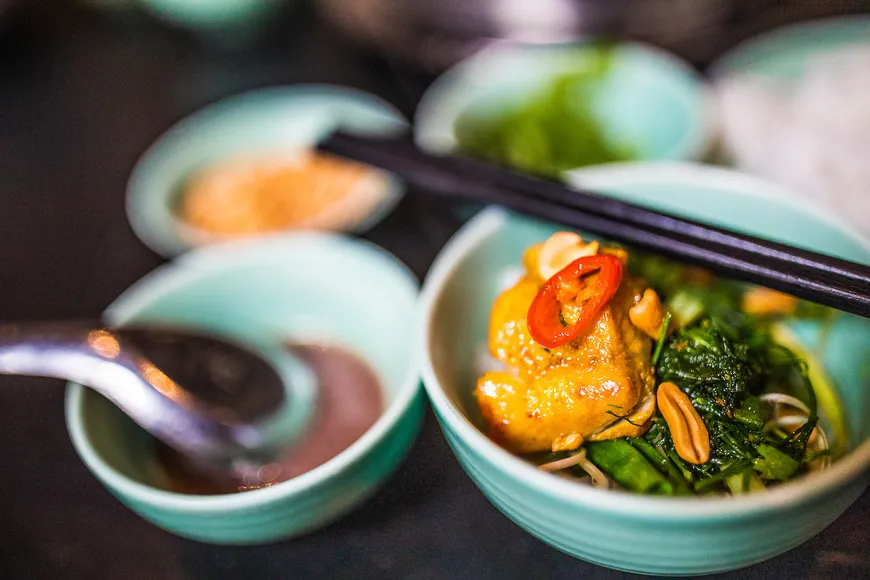 Cha Ca La Vong, turmeric-marinated fish with dill and green onions cooked tableside
Cha Ca La Vong, turmeric-marinated fish with dill and green onions cooked tableside
Try it: Cha Ca Thang Long Restaurant, 19-21-31 Duong Thanh, Hoan Kiem, Hanoi
17. Nộm Hoa Chuối
Nộm hoa chuối, or banana flower salad, is a visually stunning and refreshing Vietnam specialty. It typically consists of finely shredded banana flowers tossed with pickled carrots, fresh coriander, lotus root, and cabbage. Depending on the season, ingredients like pomelo, julienned green mango, or papaya might be added to the mix, contributing different textures and flavors.
While often served as a vegetarian dish, some preparations include chicken, beef, or shrimp. The salad is bound together with a vibrant nước chấm sauce, providing a balance of sweet, sour, salty, and spicy notes. Crushed peanuts and bird’s eye chili are sprinkled on top for crunch and heat. A squeeze of lime adds a final burst of freshness, making this salad a perfect counterpoint to richer dishes.
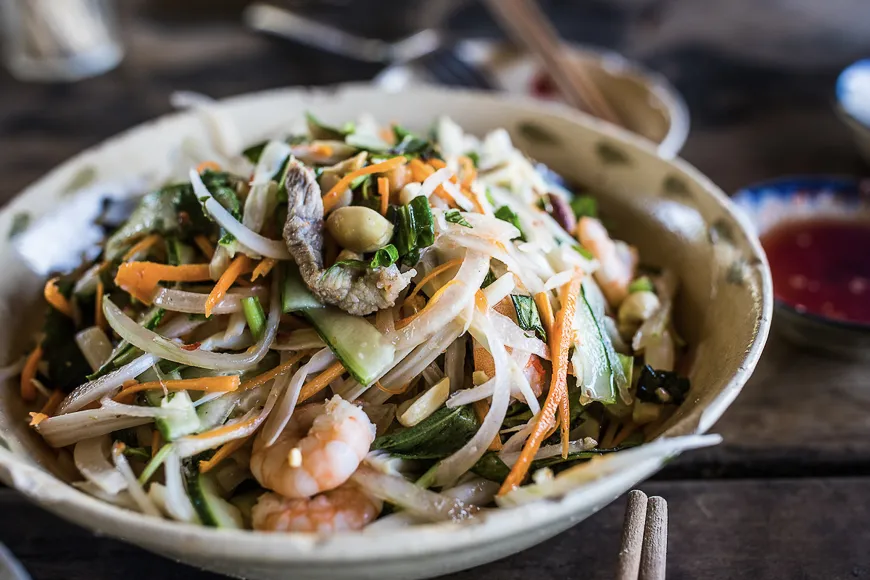 Nom Hoa Chuoi, Vietnamese banana flower salad with vegetables, herbs, and peanuts
Nom Hoa Chuoi, Vietnamese banana flower salad with vegetables, herbs, and peanuts
Try it: Mountain Retreat, 36 Le Loi, Ben Nghe, District 1, Ho Chi Minh City
18. Bánh Cuốn
Bánh cuốn is a delicate and savory Vietnam specialty made from large, thin sheets of steamed rice flour batter. These soft, translucent sheets are typically wrapped around a filling of seasoned minced pork and finely chopped wood-ear mushrooms.
The rolls are gently folded and often cut into segments. Bánh cuốn is always made fresh-to-order, ensuring its soft, slightly chewy texture. It is usually topped with crispy fried shallots and served with a side bowl of a lightened fish sauce-based dipping sauce, often containing slices of Vietnamese pork sausage (chả lụa). Enjoyed by locals often for breakfast, you can add fresh herbs to your plate to brighten each bite.
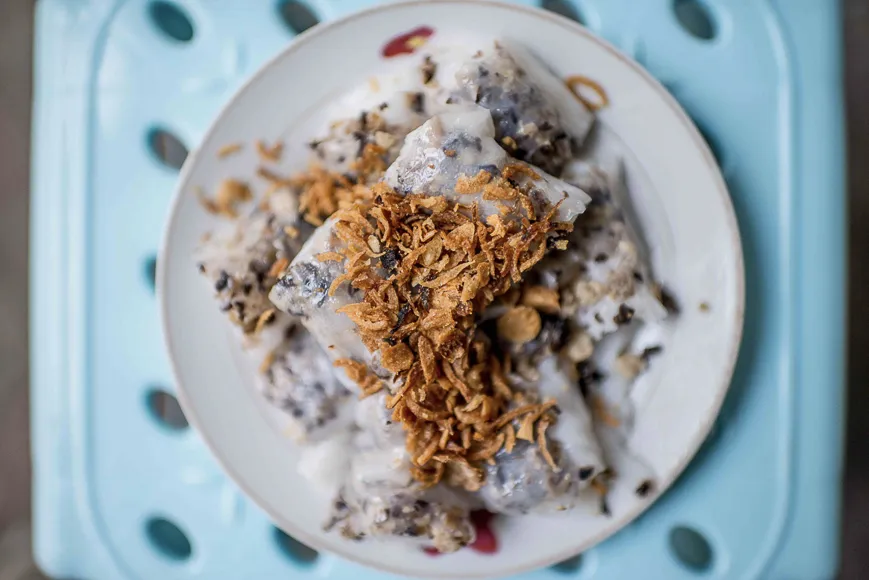 Banh Cuon, Vietnamese steamed rice rolls filled with pork and mushrooms, topped with fried shallots
Banh Cuon, Vietnamese steamed rice rolls filled with pork and mushrooms, topped with fried shallots
Try it: Bánh Cuốn 101 Bà Triệu, 147 Triệu Việt Vương, Hai Bà Trưng District, Hanoi
19. Bún Chả Cá
Bún chả cá, or fish cake noodle soup, is a Vietnam specialty that showcases interesting regional variations. While the core ingredients – spaghetti-like rice vermicelli (bún), fish cakes (chả cá), and fresh herbs – remain consistent, local twists differentiate versions across the country.
The image shows bún chả cá Nha Trang, from the central coastal city of Nha Trang. This version includes not only fish cakes but also bouncy squid cakes, fresh dill, fried green onion, and tomato, resulting in a light and slightly sour broth. Slurp this delicious soup with a side of greens and a squeeze of lime to enhance the flavors.
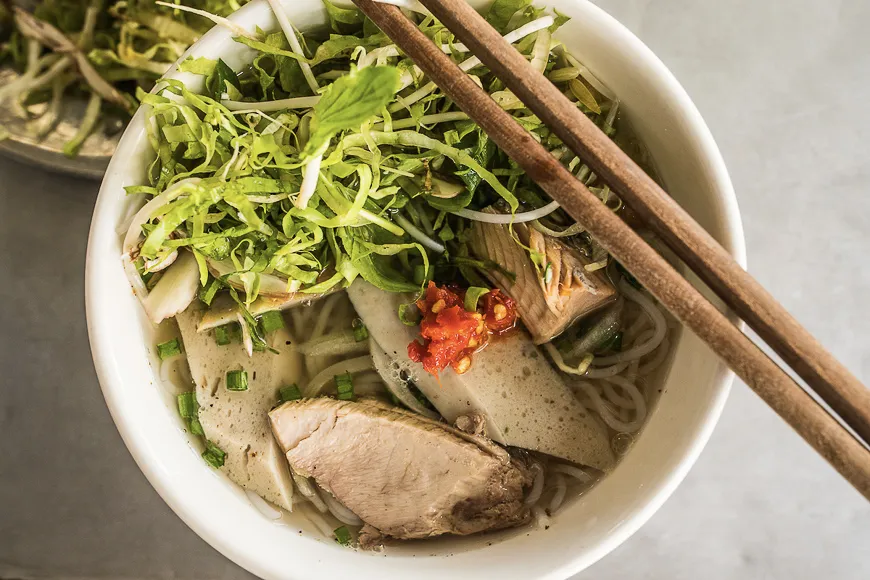 Bun Cha Ca Nha Trang, fish cake and squid cake noodle soup with tomatoes and dill
Bun Cha Ca Nha Trang, fish cake and squid cake noodle soup with tomatoes and dill
Try it: Bún Cá Mịn 170 Bạch Đằng, Tân Lập, Nha Trang
20. Bún Bò Cuốn Lá Lốt
Bún bò cuốn lá lốt is a flavorful southern Vietnam specialty featuring seasoned minced beef mixed with garlic and shallots, tightly rolled inside fragrant betel leaves (lá lốt). These small, cigar-like rolls are then grilled over charcoal, resulting in a slightly seared, crispy outer layer that seals in the juicy, peppery beef filling.
The smoky aroma from the charcoal grilling adds another layer of complexity. These flavorful parcels can be enjoyed on their own, with rice vermicelli noodles, or rolled up in rice paper with fresh herbs, offering a delightful play on textures. Dipped in a spicy fish sauce, bò lá lốt is a must-try for meat lovers exploring Vietnamese cuisine.
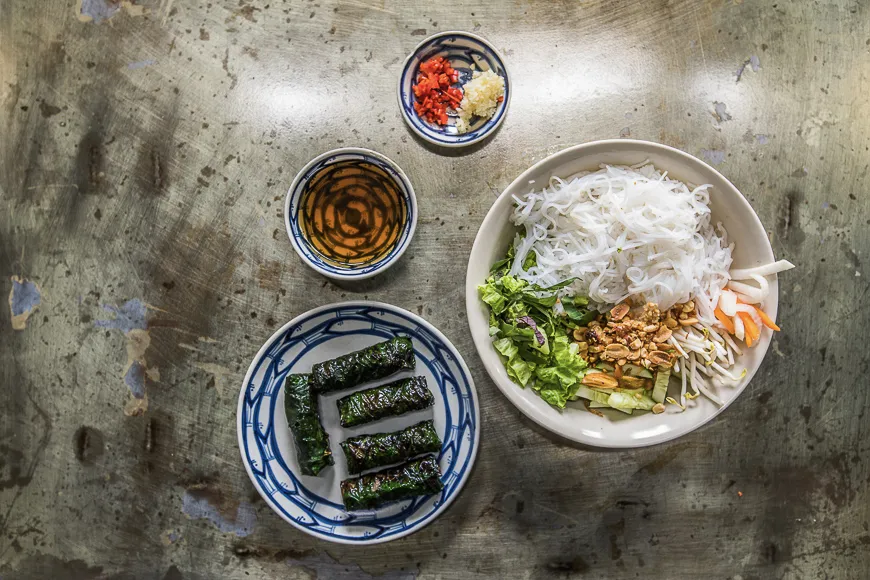 Grilled minced beef wrapped in betel leaves, Bo La Lot, a Southern Vietnamese specialty
Grilled minced beef wrapped in betel leaves, Bo La Lot, a Southern Vietnamese specialty
Try it: Cô Liêng, 321 Võ Văn Tần, District 3, Ho Chi Minh City
21. Chè
Chè refers to a diverse category of Vietnamese sweet desserts, typically served as a pudding or dessert soup. These delightful treats can be enjoyed either hot or cold. Cold chè is particularly popular, often filled with various jellied ingredients, tropical fruits like bananas, mangoes, and longan, and usually finished with a generous drizzle of rich coconut cream.
Chè is always a textural adventure, with common additions including coconut shreds, crushed ice, soft lotus seeds, and various colorful jellies. One of the most visually appealing varieties is chè ba màu, the three-colored dessert, sometimes called the rainbow dessert. This layered spectacle combines red beans, mashed mung beans, and green pandan jelly, topped with crushed ice and coconut milk, offering a refreshing and sweet conclusion to any meal.
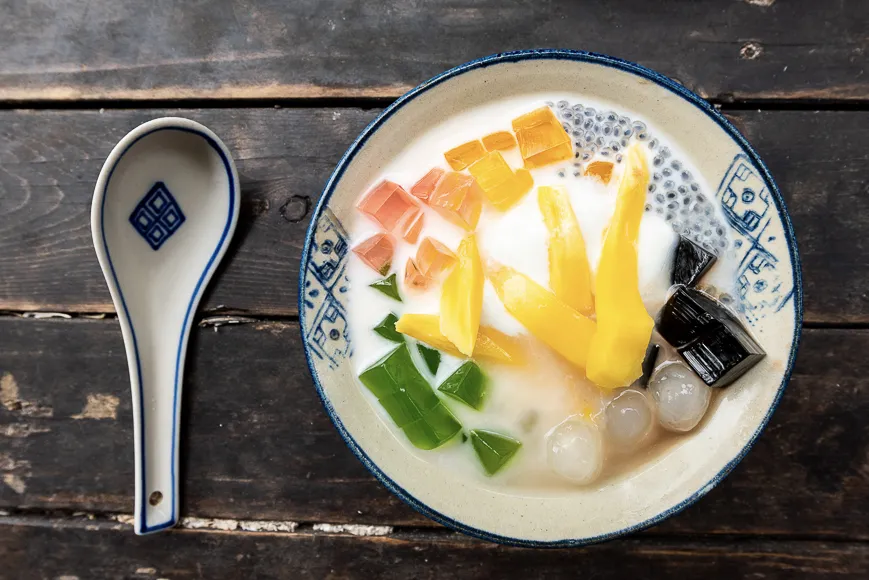 Che Ba Mau, a three-colored Vietnamese dessert soup with beans and jelly
Che Ba Mau, a three-colored Vietnamese dessert soup with beans and jelly
Try it: Che 95, 95 Hang Bac, Hoan Kiem, Hanoi
Frequently Asked Questions About Vietnam Specialties
Exploring the world of Vietnam specialties can bring up many questions for first-time visitors and food enthusiasts. Here are some common queries to help you navigate the delicious landscape of Vietnamese cuisine.
What are the most famous Vietnam specialties?
While the list is long and regional, Phở (noodle soup), Bánh Mì (Vietnamese sandwich), and Bún Chả (grilled pork with vermicelli) are arguably the most internationally recognized Vietnam specialties. However, dishes like Cơm Tấm (broken rice), Bún Bò Huế (spicy beef noodle soup), and Bánh Xèo (savory pancake) are equally famous and beloved within Vietnam.
Is Vietnamese food very spicy?
Vietnamese cuisine uses chili extensively, but spiciness varies greatly by region and dish. Central Vietnamese food, particularly from Hue, tends to be the spiciest. Many dishes allow you to adjust the spice level yourself by adding fresh chilies or chili sauce at the table. Many other Vietnam specialties have only mild heat or no spice at all.
How does Vietnamese food differ by region?
Vietnamese food has distinct regional characteristics. The North (like Hanoi) favors balanced, subtle flavors and often uses lighter broths. The Center (like Hue and Hoi An) is known for bolder, spicier flavors, richer sauces, and more complex presentations. The South (like Ho Chi Minh City and the Mekong Delta) tends to use more sugar and coconut milk, incorporating ingredients from the fertile Delta.
Can I find vegetarian Vietnam specialties?
Yes, vegetarian food is widely available in Vietnam, partly due to Buddhist influences. Many dishes can be made vegetarian (chay), and there are specific vegetarian Vietnam specialties. Look for dishes like Gỏi Cuốn Chay (vegetarian fresh rolls), various tofu dishes, and vegetable-based noodle soups. Nộm Hoa Chuối (banana flower salad) can often be made vegetarian.
Embark on Your Culinary Adventure
Discovering Vietnam specialties is an incredibly rewarding experience, offering profound insights into the country’s culture and history through its food. Each dish tells a story, reflecting the resourcefulness, creativity, and passion of the Vietnamese people for their cuisine.
So, as you plan your trip or seek out authentic Vietnamese restaurants near you, go beyond the familiar. Seek out these diverse and delicious Vietnam specialties. Allow yourself to be guided by the aromas wafting from street stalls and the friendly recommendations of locals. Your taste buds will thank you, and you’ll gain a deeper appreciation for the rich culinary landscape of Vietnam. Chúc ngon miệng! (Enjoy your meal!)
